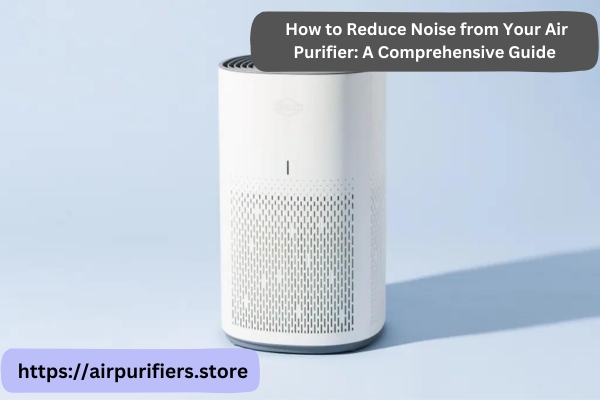How to Reduce Noise from Your Air Purifier
Air purifiers are essential for maintaining clean and healthy indoor air quality. However, the noise generated by some air purifiers can be bothersome and disruptive, particularly in quiet environments or during nighttime.
If you’re looking for ways to reduce the noise from your air purifier without compromising its effectiveness, you’ve come to the right place. (Buy On Amazon)
In this article, we will provide you with a comprehensive guide on how to minimize noise from your air purifier, allowing you to enjoy clean air without the distractions of unwanted sounds.
- Choose a Quieter Model:
When shopping for an air purifier, pay attention to the noise level ratings provided by manufacturers. Look for models that specifically mention low noise or have a noise level of 50 decibels (dB) or less. These models are designed with noise reduction features such as insulated housing, quiet fan motors, and advanced airflow systems to ensure a quieter operation. - Optimize Placement:
Proper placement of your air purifier can make a significant difference in reducing noise. Avoid placing it directly against walls or furniture, as this can cause vibrations and amplify the noise. Instead, position the air purifier in an open area, preferably on a stable surface, away from walls and obstructions. This will help minimize reverberations and ensure better airflow without compromising noise levels. - Use Lower Fan Speeds:
Most air purifiers offer multiple fan speed options. Running your air purifier at higher fan speeds can increase noise levels. If noise reduction is your priority, consider operating your air purifier at lower fan speeds. While it may slightly reduce the purification efficiency, it will significantly reduce noise output, especially during periods when the air quality is relatively good. - Time it Right:
If noise is a concern, consider adjusting the operating time of your air purifier. For example, run it during the day when you’re not in the room or set it to operate on a timer so that it turns off during sleeping hours. This way, you can enjoy the benefits of clean air without the disturbance of the air purifier noise when you need a peaceful environment. - Maintain and Clean Regularly:
A well-maintained air purifier tends to operate more quietly. Follow the manufacturer’s instructions to clean or replace the filters at recommended intervals. Accumulated dirt and debris can strain the motor and increase noise levels. Additionally, ensure that the air purifier’s components are properly assembled and tightened to minimize rattling noises.
- Consider White Noise Options:
If reducing the noise from your air purifier is challenging, you can explore options to mask the noise with soothing sounds. Consider using a white noise machine, a fan, or ambient sounds like gentle rainfall or calming music to create a pleasant auditory environment while the air purifier operates. - Check for Loose Parts:
Sometimes, loose parts or components within the air purifier can contribute to increased noise levels. Before assuming that the noise is an inherent feature of the purifier, carefully inspect it for any loose screws, panels, or filters. Tighten or secure them properly to eliminate any rattling or vibrating noises. - Use Soundproofing Materials:
If you’re dealing with persistent noise issues, you can consider using soundproofing materials to minimize the sound coming from your air purifier. Acoustic foam panels or sound-dampening mats can be placed around the purifier or in the surrounding area to absorb and reduce noise. This can be particularly useful if you have a dedicated space or room for the air purifier. - Upgrade to a Noise-Canceling Air Purifier:
Some air purifiers are specifically designed to reduce noise levels by incorporating advanced noise-canceling technology. These models use sound-absorbing materials, insulated housing, and noise-reducing fans to create a quieter operation. If noise reduction is a top priority for you, investing in a noise-canceling air purifier can be a worthwhile option. - Seek Professional Assistance:
If you’ve tried various methods to reduce the noise from your air purifier and are still facing significant issues, it may be beneficial to consult the manufacturer or a professional technician. They can inspect the unit, identify any underlying mechanical issues, and provide expert guidance on resolving the noise problem. - Consider Alternative Air Purification Solutions:
If noise reduction remains a persistent challenge, you may want to explore alternative air purification solutions that are known for their quieter operation. For example, instead of a traditional air purifier with a fan, you could consider options such as electrostatic precipitators or activated carbon filters. These technologies often produce less noise since they don’t rely on fan systems. - Read Reviews and Seek Recommendations:
Before purchasing an air purifier, make sure to read customer reviews and seek recommendations from trusted sources. Look for feedback specifically related to noise levels to ensure that you choose a model that aligns with your noise reduction requirements. Hearing from others who have used the same or similar air purifiers can provide valuable insights.
Conclusion:
Reducing noise from your air purifier is possible with the right strategies and considerations. By choosing a quieter model, optimizing its placement, using lower fan speeds, adjusting operating times, and maintaining it regularly, you can enjoy clean air without the disturbance of excess noise. Experiment with these techniques to find the right balance between noise reduction and effective air purification. Remember, a peaceful environment and improved indoor air quality can go hand in hand with the right approach to noise management for your air purifier.


